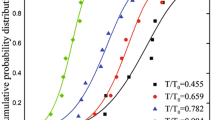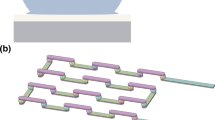Abstract
Miner’s rule assumes that damage in solder interconnects accumulates linearly under cyclic loading and is independent of the load sequence. Under these constraints, damage is equivalent to cycle ratio, defined as the ratio of the applied cycles to the cycles to failure for the specific cyclic loading condition. Due to these inherent assumptions, Miner’s rule can inaccurately estimate solder interconnect life under sequential loading conditions. A nonlinear damage model with load-dependent damage exponents would take into account the effect of loading sequence under sequential loading conditions. In the nonlinear damage model, damage is related to cycle ratio using a power law relationship with a load-dependent damage exponent. This paper presents an experimental approach to determine the load-dependent exponents under three load levels. Load drop in the specimens, as a result of cyclic loading induced changes, is used as the criterion for the damage state. The tests consisted of a series of constant amplitude (standalone) and blocks of sequential variable amplitude cyclic shear tests in a thermo-mechanical micro-scale analyzer. The load-dependent damage exponents were developed for SAC305 (96.5%Sn + 3.0%Ag + 0.5Cu) solder. The result of the study can be used for SAC305 damage accumulation model formulation. Further, the experimental approach can be used to generate additional fatigue data under variable amplitude loads.
Similar content being viewed by others
References
M. Miner, J. Appl. Mech. 12, 159 (1945).
A. Palmgren, Zeitschrift des Vereines Deutscher Ingenieure 68, 339 (1924).
D. Kujawski and F. Ellyim, Int. J. Fract. 37, 4 (1988).
P. Haswell, Ph.D. Dissertation (College Park, Maryland, 2001).
N. Iosipescu, J. Mater. 2, 537 (1967).
Y. Zhou, PhD Dissertation (Maryland: College Park, 2009).
C. Xu, S. Jie, and K. Kwang Soo, IJFa 28 (7), 767 (2006).
Z. Guo, A. Sprecher, and H. Conrad, in ECTC (1991), pp. 658–666.
K. Yoshiharu and O. Masahisa, J. Electron. Mater. 27, 1229 (1998).
V. Stolkarts, L. Keer, and M. Fine, J. Mech. Phys. Solids 47, 2451 (1999).
J. Shang, Q. Zeng, L. Zhang, and Q. Zhu, J. Mater. Sci.: Mater. Electron. 18, 211 (2007).
S. Wen, L. Keer, and H. Mavoori, J. Electron. Mater. 30, 1190 (2001).
G. Cuddalorepatta and A. Dasgupta, in EuroSIME (2009), pp. 1–7.
Acknowledgments
The authors would like to thank the more than 100 companies and organizations that support research activities at the Center for Advanced Life Cycle Engineering at the University of Maryland annually.
Author information
Authors and Affiliations
Corresponding author
Additional information
Publisher's Note
Springer Nature remains neutral with regard to jurisdictional claims in published maps and institutional affiliations.
Rights and permissions
About this article
Cite this article
George, E., Chen, D.Y., Osterman, M. et al. Experimental Approach to Determine Damage Curves for SnAgCu Solder Under Sequential Cyclic Loads. J. Electron. Mater. 49, 1412–1420 (2020). https://doi.org/10.1007/s11664-019-07811-5
Received:
Accepted:
Published:
Issue Date:
DOI: https://doi.org/10.1007/s11664-019-07811-5




